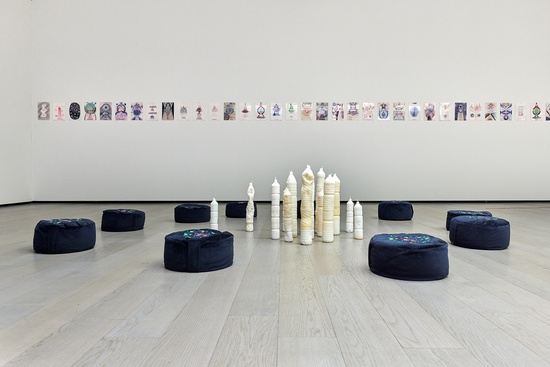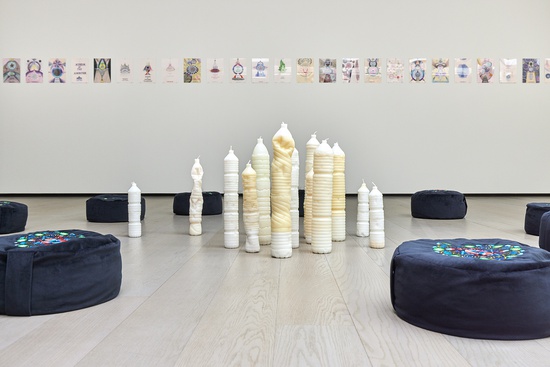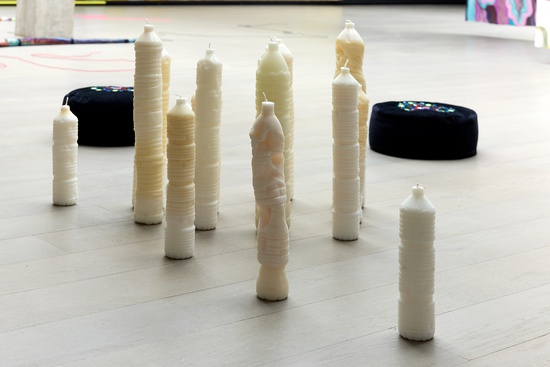4. Égrégorien Candle
Léo Luccioni
(2020)
A huddle of long, slender candles teeters towards the gods. Look closer: these wax columns have been shaped by plastic bottles, the kind you can buy in bulk at a budget supermarket. The imprint left by the plastic’s embrace show the malleability of their casts: pops and dents in the surface of the material; their ridged, moulded shape welded together to extend upwards. Towering, monumental, precarious; like a gothic cathedral.
The idea of gothic architecture is to trick the beholder into believing only God could have made this—so impossible the upwards ascents, so beautiful the intricate detailing! In this arrangement of wax candles by Léo Luccioni, titled Égrégorien Candle, there’s more than a hint of the ecclesiastical, and yet the soul is entirely synthetic, man-made. Can objects have a spiritual weight? I’m inclined to say yes. But a plastic water bottle? Only an age of true spiritual deprivation could bestow it such status.
And yet, water is life-giving, a spiritual force in itself. Who hasn’t stood staring out to sea and felt the force of some higher power? The sea turns atheists into believers, such is the power of the sublime. A plastic water bottle, then, represents the privatisation and secularisation of that which was once communal and holy. But in a materialist age, the plastic water bottle might be the closest thing we have to a reliquary of the holy. A synthetic container for the most organic—but precarious—of substances. Destined for the recycling bin, it is designed to be remelted, remoulded, malleable. Perhaps plastic, this most unholy of materials, and which wreaks havoc on the ecosystem, is the ultimate shapeshifter: always reincarnated, never dead.
Scattered around these tapering shrines are a series of circular poufs—the kind you might spot at a wellness retreat. Their surface fabric is the kind of black velour favoured by teen witches and urban goths. Emblazoned on their surface, a ring of colourful shapes and geometric forms that could be a sequence of occult glyphs, but are instead revealed to be the logos of various corporate giants: Twitter, BP, Adidas, Pepsi, Mastercard, McDonalds; signs and symbols plucked from the spiritual vacuum of post-Fordist economics. The title of this work, Égrégorien Zaofu.
Egregore (in French: égrégore) is an occult term relating to a kind of collective energy of consciousness arising from a group of people. It may manifest as thoughtforms, a charged feeling, a drive or intent that—though by definition is non-physical—may feel palpable. In a social sense, it might refer to how our mentality shifts in a group setting: how a group might take on an autonomous personality to the extent it can influence its members; groupthink. From a more materialist perspective, it could manifest in something as banal as meme culture.
In Luccioni’s titles, égrégore is spliced with the French rien (nothing). This blunt undercutting of the spiritualist with the nihilist finds a formal parallel in his sculptural objects. Quasi-esoteric objects—those towering candles, those cosmic circular poufs—suggest spiritualism and ritual, but on closer inspection bear the stamp of late capitalism. Luccioni’s artworks express his ambivalence to this everyday consumerism: at once allured and repelled by the fetishism of plastic objects, packaging and Big Tech. Luccioni has, in recent years, adopted a more environmentally conscious approach to art-making. Though this isn’t evident visually in the objects themselves, it does demand we ask of ourselves the role art plays in our culture of consumption, waste, and linear economy, and demand a better alternative.
Text by Rosa Abbott



